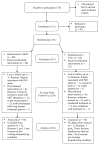Two-year follow-up of a randomized effectiveness trial evaluating MST for juveniles who sexually offend
- PMID: 24188082
- PMCID: PMC4490861
- DOI: 10.1037/a0034710
Two-year follow-up of a randomized effectiveness trial evaluating MST for juveniles who sexually offend
Abstract
Building on prior efficacy trials (i.e., university-based, graduate students as therapists), the primary purpose of this study was to determine whether favorable 12-month outcomes, obtained in a randomized effectiveness trial (i.e., implemented by practitioners in a community mental health center) of multisystemic therapy (MST) with juveniles who had sexually offended (JSO), were sustained through a second year of follow-up. JSO (n = 124 male youth) and their families were randomly assigned to MST, which was family based and delivered by community-based practitioners, or to treatment as usual (TAU), which was primarily group-based cognitive-behavioral interventions delivered by professionals within the juvenile justice system. Youth averaged 14.7 years of age (SD = 1.7) at referral, were primarily African American (54%), and 30% were Hispanic. All youth had been diverted or adjudicated for a sexual offense. Analyses examined whether MST effects reported previously at 1-year follow-up for problem sexual behaviors, delinquency, substance use, and out-of-home placement were sustained through a second year of follow-up. In addition, arrest records were examined from baseline through 2-year follow-up. During the second year of follow-up, MST treatment effects were sustained for 3 of 4 measures of youth problem sexual behavior, self-reported delinquency, and out-of-home placements. The base rate for sexual offense rearrests was too low to conduct statistical analyses, and a between-groups difference did not emerge for other criminal arrests. For the most part, the 2-year follow-up findings from this effectiveness study are consistent with favorable MST long-term results with JSO in efficacy research. In contrast with many MST trials, however, decreases in rearrests were not observed.
References
-
- Borduin CM, Henggeler SW, Blaske DM, Stein R. Multisystemic treatment of adolescent sexual offenders. International Journal of Offender Therapy and Comparative Criminology. 1990;34:105–113.
-
- Borduin CM, Letourneau EJ, Henggeler SW, Saldana L, Swenson CC. Treatment manual for Multisystemic Therapy with juvenile sexual offenders and their families. Charleston, SC: Department of Psychiatry and Behavioral Sciences, Medical University of South Carolina; 2005. Unpublished manual.
-
- Borduin CM, Schaeffer CM, Heiblum N. A randomized clinical trial of multisystemic therapy with juvenile sexual offenders: Effects on youth social ecology and criminal activity. Journal of Consulting and Clinical Psychology. 2009;77:26–37. - PubMed
-
- Elliott DS, Huizinga D, Ageton SS. Explaining delinquency and drug use. Beverly Hills, CA: Sage; 1985.
-
- Finkelhor D, Ormrod R, Chaffin M. Juveniles who commit sex offenses against minors. Juvenile Justice Bulletin 2009 Dec;
Publication types
MeSH terms
Grants and funding
LinkOut - more resources
Full Text Sources
Other Literature Sources
Medical


